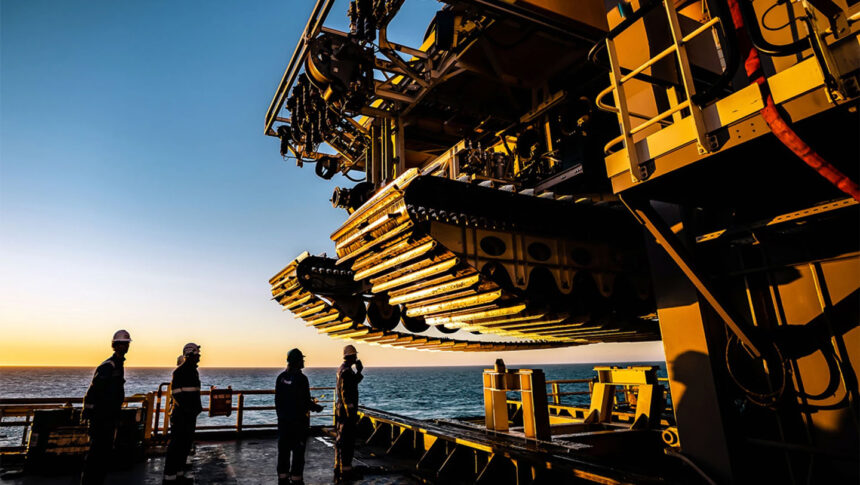An underwater gold rush may be on the horizon — or rather, a rush to mine the seafloor for manganese, nickel, cobalt and other minerals used in electric vehicles, solar panels and more.
Meanwhile, scientists and conservationists hope to pump the brakes on the prospect of deep-sea mining, warning that it may scar the seafloor for decades — and that there’s still far too little known about the lingering harm it might do to the deep ocean’s fragile ecosystems.
“The deep sea cannot become the Wild West,” said United Nations Secretary-General António Guterres at a U.N. oceans meeting in June.
That prospect is closer than ever before. In July, delegates to the U.N. body charged with stewardship over international waters are meeting to discuss whether to issue its first deep-sea mining permits. To date, the International Seabed Authority has issued 31 exploration permits to companies scanning the seafloor for likely prospects, but none yet for actual removal of ore.
But this year, the ISA is facing an unprecedented situation, says Emma Wilson, a policy officer at the Deep Sea Conservation Coalition, a nonprofit organization based in Amsterdam. “It’s the first time that an application for exploitation in international waters is actually on the table.”

That application is tied to recent actions by the United States. In April, U.S. President Donald Trump issued an executive order that would expedite deep-sea mining licenses in international waters to U.S.–based companies — by issuing them through the National Oceanic and Atmospheric Administration, rather than through the ISA.
The next day, Canada-based The Metals Company, which has a U.S. subsidiary, applied to NOAA for the world’s first deep-sea mining permit.
Gerard Barron, CEO of the Metals Company, had expressed frustration in March in an open letter on the company’s website that, after years of wrangling, ISA’s member states have still not agreed upon regulations for seabed mining, necessary to issue permits. “We are increasingly concerned that the ISA may not adopt the [mining regulations] in a timely manner, and that the regulations may be written in a way so as to not allow commercial enterprises to operate,” Barron wrote.
For the United States to circumvent the ISA’s authority to issue seabed mining permits would “violate international law and undermine the principle of the seabed as the common heritage of humankind,” said ISA Secretary-General Leticia Reis de Carvalho, in response to the executive order.
What will come out of this year’s meeting is uncertain. But one possibility is that after years of dispute and negotiation, the ISA might feel pressured into fast-tracking its own mining permits, Wilson says.
That’s especially worrisome, she says, because the ISA is also charged with protecting these deep-sea environments — and there is not yet a regulatory framework in place to do so.
In the dark
Determining how best to protect deep-sea ecosystems is especially challenging because there are so many unknowns — not just about the possible impacts of mining, but also about what sorts of creatures live in the deep.
Two-thirds of the planet is covered by deep ocean waters, mysterious ecosystems and murky stretches of seafloor hidden at least 200 meters below the surface. The deep ocean is Earth’s lifeline in myriad ways: It sequesters carbon dioxide from the surface, helping to regulate the planet’s climate; upwelling of deep ocean waters brings nutrients to the surface, nurturing phytoplankton that generate up to 80 percent of Earth’s oxygen; seafood feeds a fifth of the world’s population each year; and discoveries of chemical compounds from marine sponges and other organisms have been the source of treatments for HIV, breast cancer and COVID-19, among other diseases.
But only a minuscule fraction of the deep ocean — less than 0.001 percent — has ever been observed over decades of deep-sea exploration, researchers reported May 7 in Science Advances. And that dearth of knowledge is especially problematic because human activities, including deep-sea mining, are now threatening to cause irreparable damage to the region, says oceanographer Katy Croff Bell, founder and president of the nonprofit Ocean Discovery League, based in Narragansett Pier, R.I.
“There have been amazing strides, especially in the last decade, to study the deep ocean,” says Julia Sigwart, a marine biologist at Senckenberg Natural History Museum in Frankfort, Germany. “But there is so much left to discover … unnamed and unprotected.”
In 2001, a curious snail called the scaly-foot gastropod — or, more formally, Chrysomallon squamiferum — was found living near deep-sea hydrothermal vents, scavenging iron sulfide spewing from the vents to incorporate into its shell. In 2015, C. squamiferum was added to the International Union for Conservation of Nature’s Red List of threatened species — the first deep-sea creature designated as endangered by the prospect of deep-sea mining.
But there are likely many others. For example, there’s a tiny deep-sea crustacean that lives on polymetallic nodules, chunks of rock scattered in regions of the Pacific Ocean seafloor that are enriched in manganese, nickel, cobalt and copper. Researchers describing the creature in 2020 dubbed it Macrostylis metallicola, after the band Metallica. Scavenging the nodules for their metals would also remove its home, Sigwart says. “Mining could cause potentially irreversible impacts” for these and many other still-unnamed species.

“There are a variety of different habitats within the abyssal landscape, and it is likely that they respond differently to disturbance, and have different sensitivities,” says Daniel Jones, an oceanographer at the National Oceanography Centre in Southampton, England. Deep-sea research is beginning to reveal abundant new forms of life, and diverse new habitats. But “their resilience to impact [is a] big remaining question.”
Long-lasting scars
Scientists have warned for years that the hunt for metals and minerals in the deep sea could hurt deep-sea ecosystems, including microbes that are at the base of the ocean food web. Grooves cut in the seafloor by dragging equipment to scoop up polymetallic nodules could disturb the microbial populations in the sediment for decades, given the very slow sediment accumulation rates in the deep sea. Similarly, a recent study of the impact of striations cut by years of ships anchoring in the seafloor below Antarctic waters showed crushed sponge colonies and little to no marine life at the disturbed sites.
In March, Jones and his colleagues reported that four decades after a company tested out a strategy for the collection of polymetallic nodules, the seafloor ecosystem has still not fully recovered. In 2023, the team visited the site of the original 1979 mining operation, a mere four-day test of equipment in a region of the North Pacific Ocean known as the Clarion-Clipperton Zone.
The operation had used a remote-operated mining vehicle to scoop up the nodules, and “the tracks … looked very similar to when they were created 44 years ago,” Jones says. The test mining also kicked up sediment across an area of about half a square kilometer — a relatively small plume, compared with full-scale mining plumes that are expected to spread across tens of square kilometers of seafloor each year, he adds. Sediment plumes can clog seafloor organisms’ filtration and breathing structures, create visual and mobility barriers for organisms, and introduce heavy metals into the food chain.

In the aftermath of the 1979 test, some creatures have begun to reestablish themselves, Jones says. Generally, those are more mobile creatures and larger-bodied denizens of the deep. But the scars persist, the team says — suggesting that impacts in the abyss could linger for decades.
The Metals Company points to dozens of research studies it has contributed to public databases over the last decade, including data on the possible impact of mining collected during a 2022 deep-water test of equipment to test polymetallic nodules. “We believe preliminary analysis is demonstrating that much of the conjecture around environmental impacts of nodule collected is not supported by the science,” said Michael Clarke, the company’s Environmental Manager, in a 2024 statement.
But what has been observed still just barely scratches the surface of what is down there, opponents say. “We can’t know what the impacts of human activities are going to be until we have the baseline knowledge of what’s there,” Bell says. “And we don’t have that. Every cruise, every dive, we find something new. And there’s so much left to be explored and understood.”
Hitting pause
As the ISA meeting gets under way, researchers and environmental groups like the Deep Sea Conservation Coalition are calling for a moratorium on seabed mining, at least until ISA finalizes a framework of environmental protections from that mining. The current draft of the mining code that is under discussion is “deeply flawed and incomplete,” the coalition states.
Developing an effective set of protections could delay deep-sea mining activities by at least a decade, given how little is currently known. “We are hearing from independent scientists that at least another 10 to 15 years of research is required to be able to inform such a regulatory network,” Wilson said June 30 at a webinar held by the coalition for news media ahead of the ISA meeting. “The rush is out of step with the knowledge,” she added. “It’s an unreasonably accelerated pace of work.”

And by that time, battery technology may have moved past the urgent need for these elements for renewable energy technologies. Lithium-ion batteries, which incorporate cobalt, helped drive the push to mine elements from the seafloor, but they “are in many respects yesterday’s technology,” said venture capitalist Victor Vescovo, founder and CEO of Dallas-based Caladan Capital, at the same webinar.
“China produces more EV batteries than anyone on Earth, and most of them are lithium-iron-phosphate,” Vescovo said. “There’s no cobalt, manganese or copper. They don’t have quite the energy density [of lithium-ion batteries], but they have a longer life cycle and are cheaper to produce.” Other next-generation batteries that are based on sodium and iron are in development, would be even cheaper, and may be available in the next few years.
Proponents of deep-sea mining, including The Metals Company, assert that it’s needed because these metals are essential to fueling a green transition away from fossil fuels. “The biggest threat to the oceans is climate change,” the company’s website states. “We believe the top priority for the entire planet — including the oceans — should be achieving net-zero emissions.” Mining the oceans can also “alleviate some of the pressures on fragile terrestrial ecosystems” due to land-based mining, the company suggests.
But it’s “neither economically nor politically plausible” for deep-sea mining to replace terrestrial mining of these elements, which are both more abundant and more accessible on land, counters Justin Alger, a political scientist at the University of Melbourne in Australia, and colleagues May 10 in npj Ocean Sustainability. As a result, deep sea mining would do little to actually alleviate social or environmental pressures of terrestrial mining, he and his colleagues say. “To date, the record indicates that deep-sea mining is a risky and unprofitable investment. [It] is a multibillion-dollar solution to problems that do not exist.”








